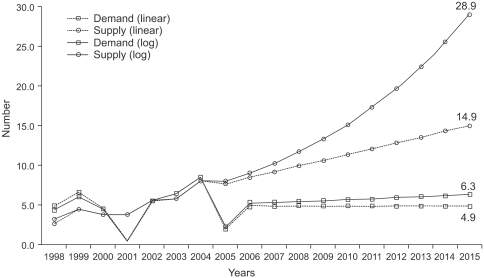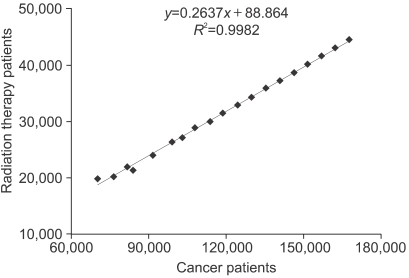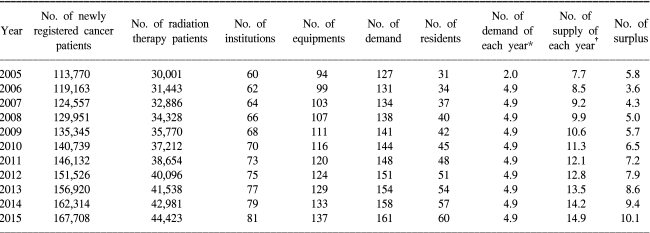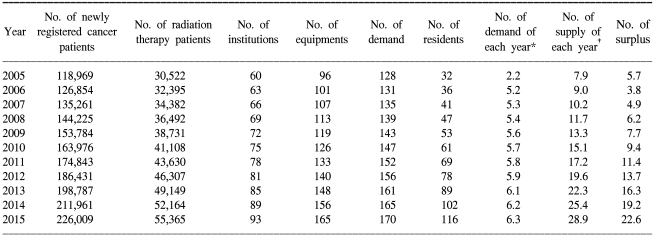INTRODUCTION
The quality and availability of radiation therapy for treating cancer is a major concern of the radiation oncology community. In the recent few years, there has been a considerable increase in the number of residents applying for training in radiation oncology. About 15 to 20 residents are entering every year and this increase is evident in the first, second and third grade residents so that the number of residents in training in early 2006 is more than 100% higher than for the 3 previous years. When considering that only 127 radiation oncologists were in practice until 2004 and the most of the radiation oncologists in Korea are not apt to open their own private clinic because of the high price of equipment, this increase clearly indicates that there will be a surplus of radiation oncologists in the coming years. Such a surplus could have a significant negative effect on the quality of practicing radiation oncology in this country. The purpose of this research is to discern and address the issues related to the supply of radiation oncology manpower and the distribution of physicians.
MATERIALS AND METHODS
The statistical data of the Annual Report of the Korea Central Cancer Registry (KCCR)(1) from 1997 to 2002 and the Annual Report of the Korean Society of Radiation Oncology (KOSTRO)(2,3) from 1997 to 2004 were used for this study. Based on these data, we predicted the number of new cancer patients, the number of new radiation therapy patients, the number of new radiation therapy organizations and the number of new radiation oncologists up to year of 2015. The estimated supply and demand were also calculated with the Microsoft Excel® program (Microsoft, Redmond, WA) with using both the linear regression function and the exponential function. Linear regression functions for the demand of radiation oncologists were created in relation to the number of new cancer patients, the number of radiation therapy patients and the number of institutions. With the estimated demand for radiation oncologists, we calculated the number of radiation therapy patients per radiation oncologist that is needed to balance the supply and demand.
RESULTS
1) Statistics
The number of newly registered cancer patients increased from 70,619 in 1997 to 99,025 in 2002 (140%) (Table 1). During this period, the number of radiation therapy patients increased from 19,773 to 26,218 (133%). In the mean time, the radiation therapy organs increased from 41 to 53 (130%), the machines increased from 61 to 82 (135%) and the radiation oncologists increased from 100 to 115 (115%). The five year average percentage of patients who receive radiation therapy was about 26.2%.
2) Estimated demand by the linear regression method
There were several assumptions to estimate. First, the increasing patterns of each category do not change through the given period. Second, current radiation oncologists in practice will resign at age 65, and 1.5 new radiation oncologists per year were added to the supply according to the age distribution of the KOSTRO members. Third, everyone is trying to get a job and nobody is opening their own clinic. From the 5-years data of KCCR and the 8-years data of KOSTRO, projections up to 2015 were made for each category. The function of the Microsoft Excel® program to estimate the projected numbers is "=TREND" (4). With this method, the numbers of cancer patients were projected to increase from 83,846 in 2000 to 167,708 in 2015 (200%). During this period, the number of radiation therapy patients is estimated to increase from 21,345 in 2000 to 44,423 in 2015 (208%). The demand of radiation oncologists is estimated to increase from 112 in 2000 to 161 in 2015 (144%). In contrast, the number of residents is estimated to increase from 15 in 2000 to 60 in 2015 (400%), which means an average of 15 new radiation oncologists are supplied annually. Eventually, it is thought that there will be about 10 surplus radiation oncologists added in the year 2015 and the accumulated surplus until this year was estimated to be 74.1 (Table 2) (Fig. 1).
3) Estimated demand by the log regression method
All the assumptions were same as with using the linear regression method. The function in the Microsoft Excel® program is "=GROWTH" (5). With this method, the number of cancer patients was projected to increase from 83,846 in 2000 to 226,009 in 2015 (269%). During this period, the number of radiation therapy patients is estimate to increase from 21,345 in 2000 to 55,365 in 2015 (259%). The demand of radiation oncologist is estimated to increase from 112 in 2000 to 170 in 2015 (152%). In contrast, the number of residents is estimated to increase from 15 in 2000 to 116 in 2015 (772%), which means an average of 28 new radiation oncologists are supplied annually. Eventually, it is thought that a surplus of 22.6 radiation oncologist will occur in the year 2015 and the accumulated surplus till this year is estimated to be 121 (Table 3) (Fig. 1).
4) Relationship of variables
Estimating the demand for radiation oncologist has many variables. For example, with the increased number of radiation physicists, dosimetrists and nurse oncologists, many physicians may be able to treat more patients without increasing their time spent at work. On the other hand, as newer high technologies such as IMRT or IGRT are being introduced, these require a larger number of physicians and their time. Therefore, it is very difficult to make projections about the future medical staffing requirements. However, there are factors that consistently affect the number of radiation oncologists. Those are the number of radiation therapy patients, the number of radiation therapy organizations and the amount of equipment. The number of cancer patients indirectly affects the number of radiation oncologists by increasing the number of radiation therapy patients. Several equations were drawn from the previously known data. When setting the number of cancer patients as the output variable y and the number of radiation therapy patients as the input x, an equation y=0.2637x+88.864 is drawn and the coefficient of determination is R2=0.9982 (Fig. 2). This explains that when there is an increase of 10,000 cancer patients, about 2,637 of then will be new radiation therapy patients, which means only 26.37% of cancer patients are receiving radiation therapy. Likewise, when putting the number of radiation oncologists as y and each other variable as x, their gradient and absolute numbers can be calculated. According to the equations, there is a need for 2.4 radiation oncologists for 1,000 radiation therapy patients (Fig. 3), 1.54 radiation oncologists for 1 organization and 0.78 radiation oncologists for each block of equipment. About 6 radiation oncologists are trained when 10,000 new cancer patients are available. The coefficient of determination is more than 0.98 for all the variables, which means these functions are very efficient. The relationship is shown in Table 4.
DISCUSSION
The rapid increase in the number of radiation oncologists in the Korean medical community for the coming years is evident. The problem is that radiation oncology is not like a primary care specialty where a practice can be setup without a large expenditure of capital. Furthermore, there are only a limited number of radiation oncology positions available, and this number is not easily expanded. As the number of radiation oncologists expands, the number of unemployed radiation oncologist will also rapidly expand. A very similar situation has happened in United States of America in mid 1980's. Davis et al has warned of a surplus manpower crisis facing the radiation oncology society in America (6). They suggested several points to control the number of residencies. But until 1995, the number of unemployed radiation oncologists in the US was very low-a fraction of 1% (7). Even in the year of 2005, the perception of the residents in the United States for the job market was sanguine. 84% of the residents in academic settings and 89% of those in private practice felt the market was good or very good (8). It is worth noting that there was actually a decrease in the number of residency programs in radiation oncology in the late 1980s (9). Further, the Unites States had 1.5 times more radiation oncologists and 2.5 times more megavoltage machines per million population than any other country (9).
1) Why is there a surplus?
The human resources market in the Korean radiation oncology field has several characteristics. First, to open a private clinic with a radiation oncology specialty is practically impossible because the equipment is very expensive and the Korea Health Care System does not yet permit an open system hospital. Second, the available jobs are limited to university hospitals or very few large hospitals. That is to say, a small market makes the demand elasticity stiff. Thus, even a temporal rise in the number of radiation oncologists easily leads to a surplus.
2) What is the problem?
There are several problems related to the surplus. First, a lesser proportion of cancer patients are receiving radiation therapy and currently only 26.37% of the newly registered cancer patients are enrolled for radiation therapy. This proportion is quite low in comparison with the USA or Canada where about 40% to 45% of cancer patients receive radiation therapy (9). Second, the contribution of radiation therapy patients to the increased number of radiation oncologist is also quite low. An increase of 1,000 radiation therapy patients only increases the number of radiation oncologists by 2.4. This discrepancy between the increasing number of patients and radiation oncologists has grown in recent years. From 2000 to 2004, the number of radiation therapy patients increased 35% from 21,435 to 28,787, while the demand for radiation oncologists increased only 13% from 112 to 127. The number of radiation therapy patients per radiation oncologist also increased 23% from 190 to 235. Third, the radiation oncologists of the bigger institutions treat more patients. Especially, the top 10 institutions, according to the total number of radiation therapy patients, take up 48% (14,959/30,950) of all the radiation therapy patients, while the other 45 institutions treat the other 52%. The average number of radiation therapy patients per radiation oncologist in these top 10 hospitals is 341, which is 58% higher than the average number (215) of the other institutions.
3) Where is the point of balance?
According to the number of radiation oncologists of the forthcoming supply, the number to meet the demand was estimated. With the linear regression method, the demand for radiation oncologists in 2015 was estimated to be 170. Assuming that the number of institutions and machines remains constant, if the slope between the number of radiation therapy patients and radiation oncologists became stiffer from 0.0024 to 0.0026, the demand for radiation oncologists can meet the supply. The gradient 0.0026 means that the demand for 2.6 radiation oncologists emerges when there is an increase of 1,000 radiation therapy patients. With the equation y=0.0026x+56.41, the number of radiation therapy patients needed to demand one radiation oncologist will change from 360.6 to 338.6. This equation explains that for one radiation oncologist to work, 338.6 radiation therapy patients are needed and an extra 384.6 patients are needed for each radiation oncologist to be added in an institution. The average number of radiation therapy patients per radiation oncologist in 2004 is about 230, which can be considered that there is plenty of space for more radiation oncologists. But this number should be interpreted with caution because for the radiation oncology facilities in suburban or rural areas, the average number of radiation therapy patients per radiation oncologist is far less than 230. Twenty five institutions among the total of forty five have a average number that is less than 200 per radiation oncologist. The average number of radiation therapy patients in the top 10 hospital is 423, which reveals that the majority of patients are serviced by only several large institutions. This causes a vicious cycle of diminished investigation for economic reasons and job shrinkage. Concentrating patients into several large institutions not only has a bad influence on radiation oncologists, but also on the patients. Patients of the suburban or rural areas spend more time and money to have treatment at the large institutions because they must travel and stay away from their homes and jobs for several weeks. Furthermore, the oversupply will increase competition, and it will increase conflict between different radiation oncology groups, conflict between the private sector and academia, and it will increase costs.
CONCLUSIONS
It is too late to prevent the oversupply that will occur in less than 5 years. If careful planning is executed during the next year, the oversupply will still occur, but at least the magnitude of the flood can be diminished. However, there can be legal or social risks for making collective suggestions or actions in response to an economic condition. Coordinated control of the number of residency positions should be done for the sake of the vitality of the Korean medical system.


















